Relativistic Planck gravity for Simulation Hypothesis modeling
A gravitational force between macro-objects is simulated by a (fine structure constant based) pixel lattice geometry supporting rotating particle-particle orbiting pairs. As this approach uses digital time, it is applicable for programming Planck-unit Simulation Hypothesis models [1]. Orbits between macro-objects emerge as the sum of these gravitational orbital pairs and so dimensioned constant G, h, c are not required, although for convenience gravitational orbitals can be measured in Planck units and these orbitals can be defined by units of dimensioned .
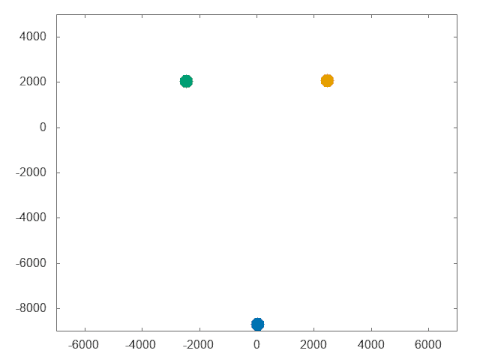
Planck unit gravity
In Planck level simulations, the simulation clock-rate is measured in discrete units of incrementing Planck time (digital time frames) forming a universe time-line against which the frequencies of Planck events can be mapped. The mathematical electron model [2] is applicable to digital Planck unit gravity simulations as it assigns to particles an oscillation between an electric wave-state (duration particle frequency) to a discrete unit of Planck-mass (at unit Planck-time) mass point-state. Mass can then be treated as a digital event rather than a constant property of the particle such that for any chosen unit of Planck time, all those particles that are simultaneously in the mass point-state can form individual rotating orbital pairs with each other. Consequently information regarding orbiting macro-objects is not required as gravitational orbits naturally emerge from the averaged sum of the underlying rotating particle-particle orbital pairs.
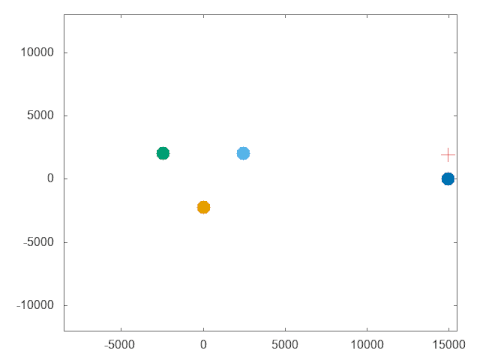
For objects whose mass is less than Planck mass, there will be units of Planck time when the object has no particles in the point-state and so no gravitational interactions. As such gravity, as a function of mass, is also a discrete event, the magnitude of the gravitational interaction approximating the magnitude of the strong force, the gravitational coupling constant representing a measure of the frequency of these interactions and not the magnitude of the gravitational force itself. Gravity and mass are therefore interchangeable terms describing different aspects of the same process.
All particles simultaneously in the mass point-state at any unit of Planck time are connected to each other by individual rotating gravitational orbitals (which can be represented as units of ). The velocity of the gravitational orbit is summed from these individual particle-particle velocities. Gravitational potential and kinetic energies are a measure of the alignment of the underlying orbitals. The orbital angular momentum of the planetary orbits derives from the sum of the planet-sun particle-particle orbital angular momentum irrespective of the angular momentum of the sun itself and the rotational angular momentum of a planet includes particle-particle rotational angular momentum.
Gravitational Orbitals
(inverse) fine structure constant α = 137.03599...,
np = pixel number
= number of Planck mass point-states per unit of Planck time
Geometrical orbitals
Orbital geometry for 2 (rotating) mass points;
- (pixel to mass ratio)
- (pixel aggregate)
- (orbital length)
Hyper-sphere co-ordinates
A relativistic hyper-sphere expands in uniform incremental steps (the simulation clock-rate) at the speed of light, and so time and velocity are constants. Particles are pulled along by this expansion, the expansion as the origin of motion, and so all objects, including orbiting objects, travel at, and only at, the speed of light in these hyper-sphere co-ordinates [3]. Time becomes time-line.
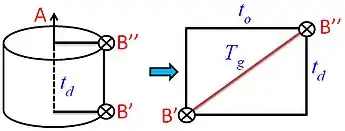
While B (satellite) has a circular orbit period to on a 2-axis plane (horizontal axis as 3-D space) around A (planet), it also follows a cylindrical orbit (from B1 to B11) around the A time-line axis in hyper-sphere co-ordinates (vertical axis). A is moving with the universe expansion (along the time-line) at (v = c) but is stationary in 3-D space (v = 0). B is orbiting A at (v = c) but the time-line axis motion is equivalent (and so `invisible') to both A and B and so from the perspective of A, the period of 1 B orbit along the observable 2-axis plane = Tg at velocity () and for B the orbital period = td.
We can simplify this cylinder by projecting it onto a 2-axis plane as the difference between 2 orbits.
We place 2 point mass on opposite poles on a circular ring forming a gravitational orbital pair. For each unit of time, the ring rotates, the degree of rotation according to the ring radius. In the simulations depicted here the rotation is anti-clockwise. An orbital of minimum radius would have an orbital period tp measured in base time units with angle of increment β
In orbits with multiple points, N>1. Example: a 4-body (4-point) orbit comprising 1-point (r = 13623) orbiting a 3-point center (see 4-body orbit diagram). The 3 center points (centered 0, 0) are then repeated to simulate increasing mass (λorbit = 2N, kr = 28456.6547....)
| total points j | orbit period k | ng | N (mass) | barycenter r/j = r-(2αnp2); |
|---|---|---|---|---|
| j1 = 1+3 | k1 = 5306671 | n = 5 | N = 1.5 | 3434, 144 |
| j2 = 1+6 | k2 = 3032251 (k1/k2 = 7/4) | n = 5/2 | N = 6.83 | 1953, 176 |
| j3 = 1+9 | k3 = 2122395 (k1/k3 =10/4) | n = 5/3 | N = 16.13 | 1366, 228 |
| j4 = 1+12 | k4 = 1632445 (k1/k4 = 13/4) | n = 5/4 | N = 29.388 | 1064, 214 |
| j5 = 1+15 | k5 = 1326037 (k1/k5 = 16/4) | n = 5/5 | N = k5/kr = 46.598 | 865, 214 |
Each of the 6 orbiting pairs are calculated independently. All results are then summed and averaged before the next unit of time is incremented. Thus the universe simulation can be updated in real-time on a serial processor.
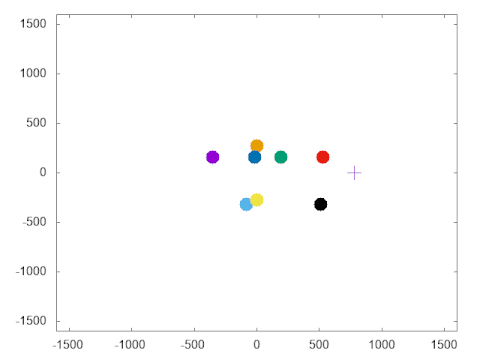
Planck units
The above can also be measured in terms of the dimensioned Planck units. As can therefore be used as a measure of length to mass, when =1, N = and so between objects A and B (where mass MA >> mB), 2Nlp = λA.
λobject = Schwarzschild radius
mP = Planck mass
lp = Planck length
- (number of particles in the Planck mass point-state per unit of Planck time)
- (converting to Schwarschild radius)
- (gravitational orbit velocity)
- (standard gravitational orbit period)
- (gravitational acceleration)
Hyper-sphere orbital
Measuring a hypersphere orbital along a 2-D plane in 3-D space
If we consider the smaller orbit as a rotation of the orbital plane itself (for both orbits, orbital velocity = c) then we can re-write the above as;
Example: B orbital period at r = 42164.170 km (n = 5889.674)
- s
- m/s
- m/s
T_g = 86164.0916523 s
t_d = 86164.0916478 s
By including the rotation of the orbital plane, B only requires td time units to complete 1 orbit in hyper-sphere co-ordinates.
Precession
The ellipticity of the B orbit around A.
semi-minor axis:
semi-major axis:
radius of curvature :
arc secs per 100 years:
Mercury = 42.98 Venus = 8.62 Earth = 3.84 Mars = 1.35 Jupiter = 0.06
The orbital plane becomes
Mercury
- s
Gravitational coupling constant
The Gravitational coupling constant αG characterizes the gravitational attraction between a given pair of elementary particles in terms of the electron mass to Planck mass ratio;
If particles oscillate between an electric wave-state to Planck-mass (for 1 unit of Planck-time) point-state then at any discrete unit of Planck time a number of particles in the universe will simultaneously be in the mass point-state. For example a 1kg satellite orbits the earth, for any given t, satellite (B) will have particles in the point-state. The earth (A) will have particles in the point-state. For any given unit of Planck time the number of links between the earth and the satellite will sum to;
The gravitational orbit can be characterized by :
If A and B are respectively Planck mass particles then N = 1. If A and B are respectively electrons then the probability that any 2 electrons are simultaneously in the mass point-state for any chosen unit of Planck time becomes αG.
Examples
i) Earth orbits
Earth surface orbit
rg = 6371.0 km ag = 9.820m/s^2 Tg = 5060.837s vg = 7909.792m/s
Geosynchronous orbit
rg = 42164.0km ag = 0.2242m/s^2 Tg = 86163.6s vg = 3074.666m/s
Moon orbit (d = 84600s)
rg = 384400km ag = .0026976m/s^2 Tg = 27.4519d vg = 1.0183km/s
ii) Planetary orbits
mercury: rg = 57909000km, Tg = 87.969d, vg = 47.872km/s venus: rg = 108208000km, Tg = 224.698d, vg = 35.020km/s earth: rg = 149600000km, Tg = 365.26d, vg = 29.784km/s mars: rg = 227939200km, Tg = 686.97d, vg = 24.129km/s jupiter: rg = 778.57e9m, Tg = 4336.7d, vg = 13.056km/s pluto: rg = 5.90638e12m, Tg = 90613.4d, vg = 4.740km/s
iii) The energy required to lift a 1 kg satellite into geosynchronous orbit is the difference between the energy of each of the 2 orbits (geosynchronous and earth).
Angular momentum
The orbital angular momentum of the planets derives from the angular momentum of the orbital pairs (and so is independent of the orbital angular momentum of the sun).
Orbital angular momentum
The orbital angular momentum of the planets;
mercury = .9153 x1039 venus = .1844 x1041 earth = .2662 x1041 mars = .3530 x1040 jupiter = .1929 x1044 pluto = .365 x1039
Orbital angular momentum combined with orbit velocity cancels n giving an orbit constant. Adding momentum to an orbit will therefore result in a greater distance of separation and a corresponding reduction in orbit velocity accordingly.
Rotational angular momentum
The rotational angular momentum contribution to planet rotation.
Earth:
Trot = 83847.7s (86400)
vrot = 477.8m/s (463.3)
- (.705)
Mars:
Trot = 99208s (88643)
vrot = 214.7m/s (240.29)
- (.209)
Rotational angular momentum combined with vrot
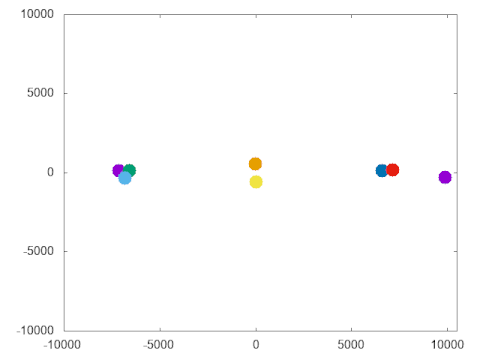
Planck force
a)
b)
Atomic orbitals
Although beyond the scope of this page, we can look at how this may apply to the atom as the difference between the 2 orbital types (gravitational and atomic) should be primarily according to geometrical considerations of the particles themselves (as gravity typically applies to large groups of particles over substantial distances, smaller effects may average out).
Wave-state
To illustrate how this might apply, I use best fit geometries tp for H and P orbitals (n = 1). The electron orbits with the orbital plane (H example) and against the orbital plane (P example).
H (1s-2s) transition = 2466061413 MHz [4].
Positronium (1s-2s)= 1233607216 MHz [6]
Orbital transition
Atomic electron transition is the change of an electron from one energy level to another. The following redefines the Rydberg formula in terms of `physical' orbitals, where transition is an orbital replacement, the electron plays no pre-dominant role.
Consider the Hydrogen Rydberg formula for transition between and initial and a final orbit. The incoming photon causes the electron to `jump' from the to orbit.
The above could be interpreted as referring to 2 photons;
Let us suppose a region of space between a free proton and a free electron which we may define as zero. This region then divides into 2 waves of inverse phase which we may designate as photon () and anti-photon () whereby
The photon () leaves (at the speed of light), the anti-photon () however is trapped between the electron and proton and forms a standing wave orbital. Due to the loss of the photon, the energy of () and so stable.
Let us define an () orbital as (). The incoming Rydberg photon arrives in a 2-step process. First the adds to the existing () orbital.
The () orbital is canceled and we revert to the free electron and free proton; (ionization). However we still have the remaining from the Rydberg formula.
From this wave addition followed by subtraction we have replaced the orbital with an orbital. The electron has not moved (there was no transition from an to orbital), however the electron region (boundary) is now determined by the new orbital .
External links
- Mathematical electron
- Relativity in the Planck level
- the Planck unit black hole
- Digital time in a simulation hypothesis
- Simulation hypothesis
- the Source Code of God; a programming approach -online resource
- Simulation Argument -Nick Bostrom's website
- Our Mathematical Universe: My Quest for the Ultimate Nature of Reality -Max Tegmark
References
- ↑ Macleod, Malcolm J.; "Programming gravity for Planck unit Simulation Hypothesis modeling". RG. Feb 2011. doi:10.13140/RG.2.2.11496.93445/7.
- ↑ Macleod, M.J. "Programming Planck units from a mathematical electron; a Simulation Hypothesis". Eur. Phys. J. Plus 113: 278. 22 March 2018. doi:10.1140/epjp/i2018-12094-x.
- ↑ Macleod, Malcolm J.; "Programming relativity for Planck unit Simulation Hypothesis modeling". RG. Feb 2011. doi:10.13140/RG.2.2.18574.00326/2.
- ↑ Parthey CG et al, {Improved measurement of the hydrogen 1S-2S transition frequency}, Phys Rev Lett. 2011 Nov 11;107(20):203001. Epub 2011 Nov 11
- ↑ Macleod, M.J. "Programming Planck units from a mathematical electron; a Simulation Hypothesis". Eur. Phys. J. Plus 113: 278. 22 March 2018. doi:10.1140/epjp/i2018-12094-x.
- ↑ M. S. Fee et al., Phys. Rev. Lett. 70, 1397 (1993)